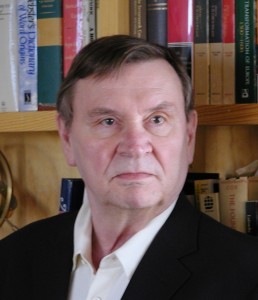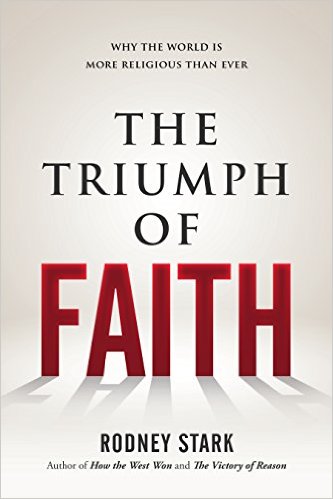By Jeff Brumley
You don’t have to follow the news that closely to hear that Christianity is on the ropes in America, that worship attendance is spiraling downward, that young people want nothing to do with church and that Americans are increasingly non-religious.
It’s safe to say that survey after survey has pronounced that, for Christianity in America, the sky is falling.
“Well, it isn’t,” said Rodney Stark, a sociologist of religion and author of a new book, The Triumph of Faith: Why the World Is More Religious than Ever. “It’s a religious world out there.”

Stark, distinguished professor of social sciences and co-director of the Institute for Studies of Religion at Baylor University, said much of the recent research on the state of faith in the United States is misinterpreted by scholars, reporters and bloggers — and by most of the church.
The steady stream of data on topics like the rise of the “nones” and Millennials abandoning church is often viewed through lenses of anti-religious bias, the desire to sensationalize or just plain fear, Stark told Baptist News Global.
The numbers are usually correct, Stark added, but the conclusions miss the mark.
“It’s not that what they are doing is wrong, it’s that they are misinterpreting what they get,” he said. Why?
“Some prefer bad news and … a lot of it is pure ignorance.”
‘And so it goes’
Stark said he bases that assessment on the Gallup World Poll, which is published in his book and which has been conducting surveys since 2005 in 163 nations.
What he found in the data is that 81 percent of the global population claims to belong to one of the world’s major religious traditions.
Almost 75 percent of those polled say religion is an important part of their daily lives and another 50 percent say they have been to a religious service in the past week.
“That’s just about everybody,” he said.

Atheism, he added, is practically non-existent. A 1944 U.S. Gallup poll reported that only 4 percent of Americans said they do not believe in God — the same percentage as 2015.
Not only that, but Christianity is booming around the world, he said. Sub-saharan Africa has become the most Christianized continent and Catholicism is enjoying resurgence in Latin America.
“And so it goes,” he said.
And that is true in the United States, where Americans are going to church today just as they did 50 years ago, Stark said.
The rise of the so-called “nones” — people who claim no religious affiliation — doesn’t mean, as pollsters suggest, people are less religious, but that they don’t belong to a church or other religious organization.
“It means unchurched” as opposed to not religious, Stark said. “There’s a very big difference.”
‘A darned religious world’
The growing absence of young people, especially Millennials, from churches has also been misunderstood by pollsters, academics and the media, he said.
In his book, Stark includes a table showing that Christians under 30 are noticeably less likely to attend church than those who are over 30.
“But the table is from 1980,” he said.
“People under 30 have always been poorer attenders than people over 30,” Stark said. “That’s been going on as long as we have had poll data.”
He even disputes the common belief that Europeans are much more likely than most of the world to be irreligious. There is evidence from the Gallup data that belief in fortune tellers, reincarnation and mental telepathy are held by many on the continent, as The Wall Street Journal reported in a Jan. 3 view of Stark’s book.
He told BNG the contents of the Gallup survey confirmed his observations. More proof is in the declining response rates pollsters are getting for their surveys, making them unreliable in determining accurate religious beliefs and participation.
“I pretty much thought it was a darned religious world no matter what the media says,” Stark said.
Overstating religious participation
In a Jan. 8 letter to The Wall Street Journal, the Pew Research Center’s Alan Cooperman said the organization has not been alone in documenting the rise in the number of religious “nones.” Polls by Gallup, the American Religious Identification Survey and the General Social Survey have come to similar conclusions.
Cooperman acknowledged that response rates are declining and pose a challenge. But he said that challenge isn’t the one Stark claims.
Studies of low response rates show that those who do participate in surveys tend to be more likely to participate in civic activities, Cooperman said in the letter.
“In other words,” he wrote, “the data suggest that if declining response rates introduce bias into surveys about religion, they would overstate the religiousness of the population, not understate it, as Prof. Stark claims.”
Not the end of Christianity
Polling data is one thing. Experience is another. And Mark Tidsworth, a Baptist minister and congregational coach based in South Carolina, said he is witnessing the downward trends reported by Pew and others.
“What we see from behavior,” he said, “is that Christianity in particular is declining.”
Tidsworth, president of Pinnacle Leadership Associates, said he hasn’t read Stark’s book and can’t comment on whether Europeans are more spiritual than commonly believed. But he knows, as many surveys say, that church membership is dropping.

“That is consistent with the anecdotal evidence I hear from churches.”
There are some churches that are growing, but they are fewer in number than in past years, he said.
“More are happy if they can maintain their membership.”
Despite those trends, Tidsworth said he is optimistic about the future of faith in America.
“In no way is this the end of the Christian story,” he said. “This is a great way for us to adapt … and become ready to make the changes and shifts” to become healthy and relevant again.
